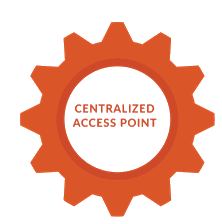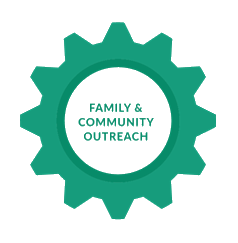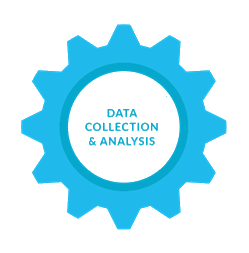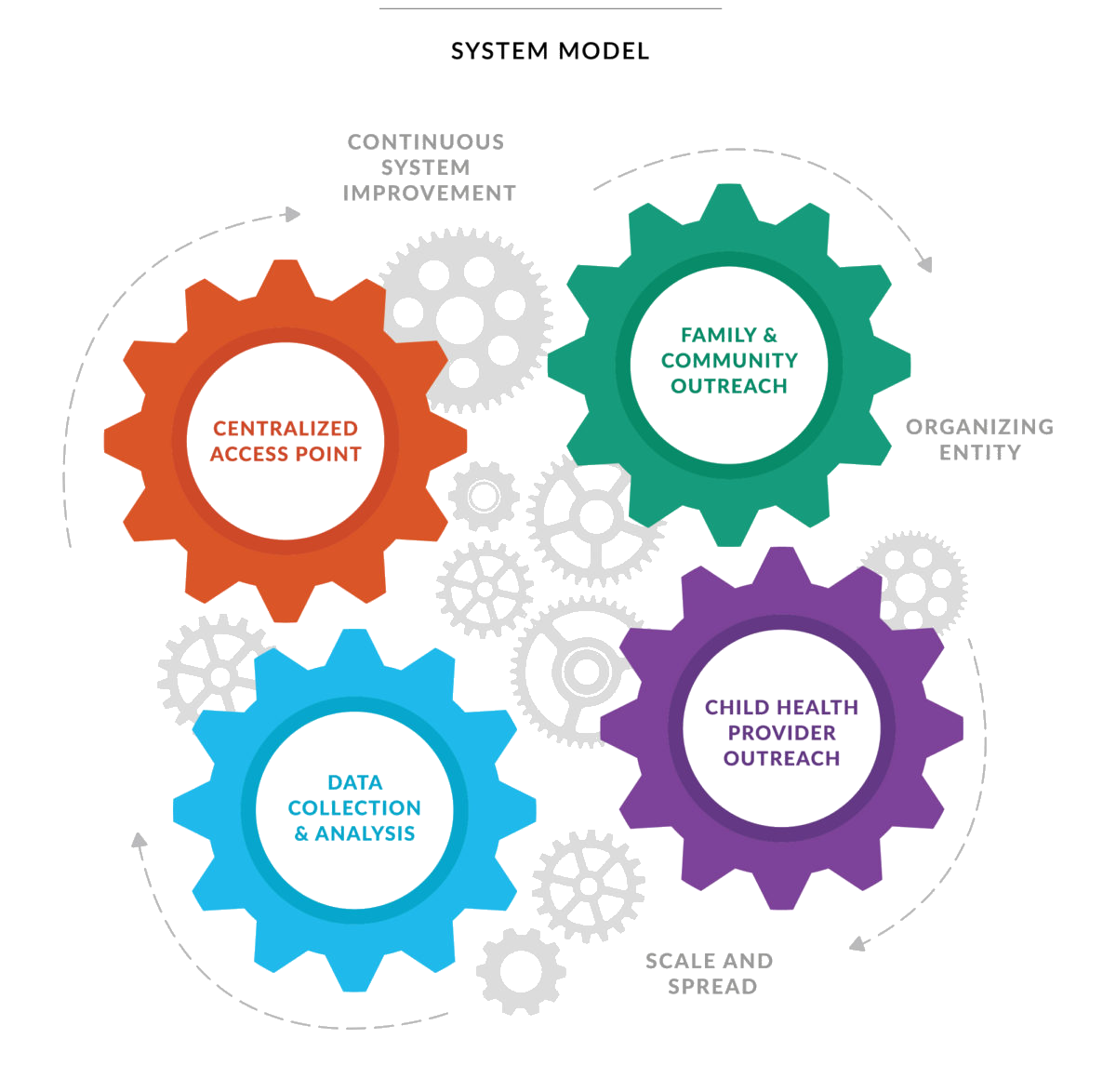A Better Future Starts with Help Me Grow
We believe that all children should be able to grow, develop, and thrive to reach their full potential.
The early years present incredible opportunity to build a strong foundation as the brain rapidly develops during the first five years of life. All children benefit from an organized system of community resources to help them thrive, like health care, quality early learning experiences, healthy nutrition, and parent support. However, when the system is not well organized, it can be difficult for families to access resources for their children and challenging for service providers to connect families to needed supports. This can have long-lasting consequences on children’s health and well-being.
A network of community resources works like a power grid. When the grid functions well, families can plug in to an organized flow of resources and easily access the ones they need.
Help Me Grow strengthens the grid by maintaining a current directory of available services and connecting service providers to each other to create an interconnected system. Families benefit as Help Me Grow listens to them, links them to services, and provides ongoing support. Help Me Grow is available to all children, including those whose families may have concerns or simply want to learn more about their child’s development.
Help Me Grow is not a stand-alone program, but rather a system model that utilizes and builds on existing resources in order to develop and enhance a comprehensive approach to early childhood system-building in any given community. Successful implementation of the Help Me Grow model requires communities to identify existing resources, think creatively about how to make the most of existing opportunities, and build a coalition to work collaboratively toward a shared agenda.
Four cooperative and interdependent Core Components characterize the Help Me Grow Model:

A Centralized Access Point assists families and professionals in connecting children to the grid of community resources that help them thrive.
 Family & Community Outreach builds parent and provider understanding of healthy child development, supportive services available to families in the community, and how both are important to improving children’s outcomes.
Family & Community Outreach builds parent and provider understanding of healthy child development, supportive services available to families in the community, and how both are important to improving children’s outcomes.
 When potential concerns are spotted early on, they can be easier to address. Child Health Care Provider Outreach supports early detection and intervention efforts and connects medical providers to the grid of community resources to best support families.
When potential concerns are spotted early on, they can be easier to address. Child Health Care Provider Outreach supports early detection and intervention efforts and connects medical providers to the grid of community resources to best support families.
 To make sure the resource grid is working effectively, Data Collection & Analysis supports evaluation, helps identify systemic gaps, bolsters advocacy efforts, and guides quality improvement.
To make sure the resource grid is working effectively, Data Collection & Analysis supports evaluation, helps identify systemic gaps, bolsters advocacy efforts, and guides quality improvement.
Help Me Grow is the seamless cooperation
of these four Core Components.

MORE ABOUT THE HMG CORE COMPONENTS
Child Health Care Provider Outreach
Child health care providers are uniquely positioned to identify developmentally vulnerable children as they have near universal access to young children that provides ongoing monitoring of children’s developmental status, as well-child health care includes developmental promotion and early identification through periodic screening. However, child health care providers often face challenges in identifying early signs of developmental or behavioral concerns, and even when needs are recognized, keeping comprehensive and updated information on community-facing services is difficult and lastly, successful connection to those programs is time-consuming. The formidable challenges of facilitating connections to needed services can be daunting for busy practitioners and potentially discourage early detection efforts.
The HMG system supports community-based pediatricians by enhancing their effective developmental promotion and early detection activities for all children and families. This support is provided through educating and motivating providers to conduct systematic surveillance and screening of young children, as well as providing community-based pediatricians with access to a centralized access point that can serve as a care coordination arm for busy pediatric primary care practices. In doing so, HMG partners with pediatricians to ensure effective linkage to appropriate programs and services.
Family & Community Outreach
Family & Community Outreach promotes HMG, facilitates provider networking, and bolsters children’s healthy development through families.
Family & Community Outreach is key to promoting the use of HMG and providing networking opportunities among families and community-based service providers. Those contributing to Family & Community Outreach efforts engage families by participating in community meetings, forums, public events, fairs, and facilitating sessions that help families learn about child development and the role of HMG. Family & Community Outreach is also about strengthening relationships with community-based service providers and knitting together the various family-serving agencies and professionals into a coordinated network.
A community presence encourages support for and participation in the HMG system and helps to market the service. It also facilitates efforts to gather and update information to include in a local early childhood resource directory.
Centralized Access Point
The Centralized Access Point typically takes the form of a call center and more recently, an accompanying virtual service, that serves as the “go-to” place for family members, child health care providers, and other professionals seeking information, support, and referrals for children. Telephone and web-based services have proven to be effective primary points of access to community resources. They are cost-effective, easy to promote, efficient in identifying needs, and effective in supporting callers and triaging to appropriate services.
The Centralized Access Point connects children and their families to services they need through the efforts of HMG Care Coordinators, Centralized Access Point staff who work to provide education and support to families around specific developmental or behavioral concerns or questions, help families recognize typical developmental milestones, provide referrals to community-based supports, empower families overcome barriers to services, and follow up with them to make sure linkages are successful.
To ensure that callers feel safe, respected, and heard, the Centralized Access Point must be adequately staffed with individuals who are trained in telephone casework and cultural proficiency, and have backgrounds in child development.
Data Collection & Analysis
Data Collection & Analysis ensures ongoing capacity for continuous system improvement, a Structural Requirement of HMG. Data is collected throughout all components of the HMG system, including child health provider outreach, family and community outreach, and within the Centralized Access Point.
The collection of a set of shared metrics across the HMG National Affiliate Network advances understanding of collective impact, informing the national narrative regarding the impact of HMG on children and families across the country. The collection of locally-sourced metrics enable HMG affiliates to benchmark progress, identify areas of opportunity and systemic gaps, determine potentially advantageous partnerships, and guide strategic quality improvement projects.
The Help Me Grow Model includes three Structural Requirements that provide the infrastructure and vision to advance efficient, effective systems of care and support that work for all families with young children.
Organizing Entity
The design and implementation of an HMG system is dependent upon communication, coordination, and integration of resources and services. Genuine collaboration is required to make changes in policies, governance, and operating procedures at the administrative and direct service levels. One of the first steps in developing an HMG system is to enlist partners who have mutual interests, service the same populations, and/or have the capacity to move the agenda forward.
The organizing entity provides administrative and fiscal oversight and initially helps identify and coordinate partners into a leadership team or steering committee that will guide the HMG system as it evolves. As the roles of each partner are defined, the responsibility for administrative and fiscal oversight may change, but having a stable administrative “home” is essential for system sustainability over the long term.
Spread & Scale
Creating systems that efficiently and effectively serve all children and families requires a vision for strategies to scale and spread the HMG system model from the outset of implementation.
HMG depends on building broad-based ownership of the system across service sectors to leverage resources and improve linkages in communities. While this type of collaboration can happen initially at the county or regional level, a system limited in geography will be limited in its ability to identify and address gaps and barriers, which are often rooted in larger, statewide challenges. In addition, the flow of funds to community services is often based on state budgets and policies and directed by state departments and agencies.
Continuous Quality Improvement
Continuous quality improvement necessary to support HMG efforts over the short- and long-term. Robust, sustainable initiatives remain so as the result of ongoing efforts to continuously improve services, processes, and partnerships. Continuous system improvement for HMG emphasizes incremental improvements over time that continue to produce the best outcomes for children and families, maximize efficiency, and yield best practices that can be applied across the National Affiliate Network.

 Family & Community Outreach builds parent and provider understanding of healthy child development, supportive services available to families in the community, and how both are important to improving children’s outcomes.
Family & Community Outreach builds parent and provider understanding of healthy child development, supportive services available to families in the community, and how both are important to improving children’s outcomes.  When potential concerns are spotted early on, they can be easier to address. Child Health Care Provider Outreach supports early detection and intervention efforts and connects medical providers to the grid of community resources to best support families.
When potential concerns are spotted early on, they can be easier to address. Child Health Care Provider Outreach supports early detection and intervention efforts and connects medical providers to the grid of community resources to best support families.  To make sure the resource grid is working effectively, Data Collection & Analysis supports evaluation, helps identify systemic gaps, bolsters advocacy efforts, and guides quality improvement.
To make sure the resource grid is working effectively, Data Collection & Analysis supports evaluation, helps identify systemic gaps, bolsters advocacy efforts, and guides quality improvement. 
